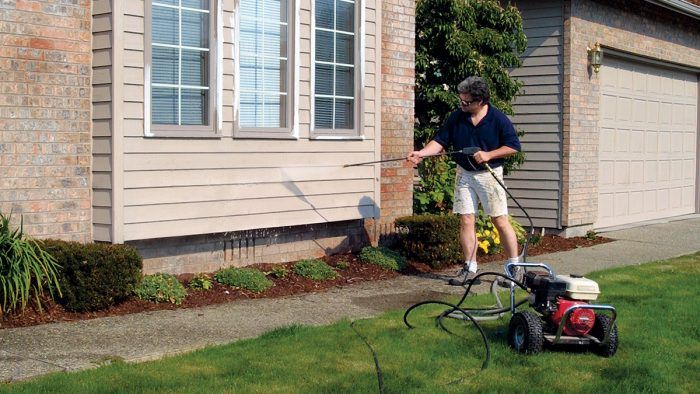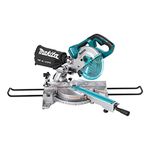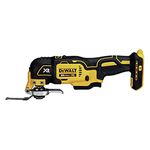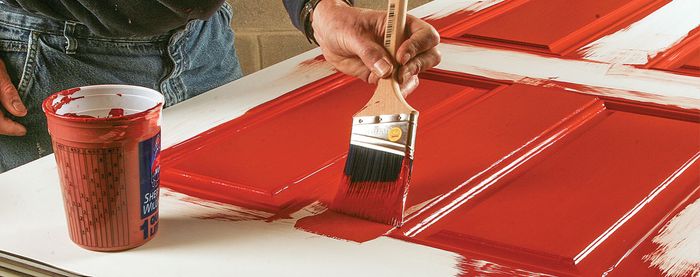The Art of Pressure Washing
There's no better way to prepare a house for painting, but be careful you're not doing more harm than good.

Synopsis: If done correctly, pressure washing can be a godsend when it comes time to paint. It can help remove dirt, mildew, algae, and oxidation — all key contributors of paint failure. This article explains power, spray position, hose attachments, and cleaning-solutions to help you ensure that your siding is properly prepped, not wrecked.
If you read the label on a few different cans of paint, you’ll notice some similarities. One way or another, the instructions will tell you to scrape all loose paint, to repair all damaged areas, and to clean the surface thoroughly. To do the best possible job, I have made pressure washing a regular step for all my finishes.
However, there is an art to pressure washing a house, whether you are doing it to prep for painting or just to clean the siding. It’s like the story of The Three Little Pigs: Too much, and you could blow your house down; too little, and you could huff and puff all day long to no effect.
A Pressure Washer is Not a Paint Remover
Pressure washers are for washing. They are not for removing paint. If you manage to use a pressure washer as a paint remover, you’re probably washing hard enough to damage the siding, and possibly forcing water inside the walls. The reason to wash the house is to remove dirt, algae, mildew, and oxidation that can cause paint failure. Loose and flaking paint should be scraped and sanded, and damaged siding and trim should be repaired before the house is washed.
Although I tend to wash harder than other contractors, I tailor my technique to each house. On an 80-year-old house, I use less pressure than on a 3-year-old repaint, and I avoid areas that may be prone to leaking. To be sure that water is not getting into walls, I always ask permission to go inside the house, where I check for leakage around doors and windows.
Although a pressure washer is not a paint remover, washing can loosen paint. So when I’m done washing the house, I check for newly loosened or flaking paint before I prime.
Bleach Cures the Mildew Problem
One of the biggest problems with existing paint jobs is mildew. Mildew discolors the paint, causes adhesion problems with new paint, and even can damage the siding. To combat this problem, I apply a 3-to-1 water to bleach solution before I pressure wash. I mix the solution in a garden sprayer and apply it to the entire house. When washing houses, I prefer the garden sprayer to the chemical injector on the pressure washer because the sprayer is easy to move around the house and up and down a ladder.
Be careful with the bleach. I’ve never had a problem, but I have heard of people experiencing adverse skin reactions to the mist. If your skin is sensitive, wear long sleeves, pants, a respirator, and rubber gloves.
Although the sprayer and pressure washer both are accurate applicators, be mindful of overspray and run-off. I generally don’t like to use chemicals on surfaces that are not going to be repainted, but if the house has a deck, I usually wash it anyway. Otherwise, I’m very careful not to let the bleach solution drip on decks or wood-shake roofs because the bleach can leave noticeable clean spots.
For more photos and details on pressure washing, click the View PDF button below.
Fine Homebuilding Recommended Products
Fine Homebuilding receives a commission for items purchased through links on this site, including Amazon Associates and other affiliate advertising programs.

Large-Capacity Lightweight Miter Saw

DEWALT 18v Cordless Multitool (DCS355)

Milwaukee Cordless Shop Vac (0880-20)






View Comments
When pressure washing it is always wise to start out in the least noticeable part of the structure. This allows for a test area that will not be noticed. When dealing with old buildings or homes you never know how different aging building materials will hold up. This is a lesson i learned the hard way starting out. I thought I was fine based off past experiences
http://www.tylerpressurewashing.com
What a great title! I instantly had to read it when I saw it. It was well written and had some great points stressing it is not a paint remover! We pressure wash for a living and can definitely tell you that you will cause major damage to wood and siding if you aren't very careful with the application of bleach or chemicals and strength of pressure.
Tyler's comment is right on as well! Better to be safe than sorry. You can always go stronger with chemicals and pressure, but you can't go back once you've damaged the surface.
Good Read!
https://www.jpow-erwash.com